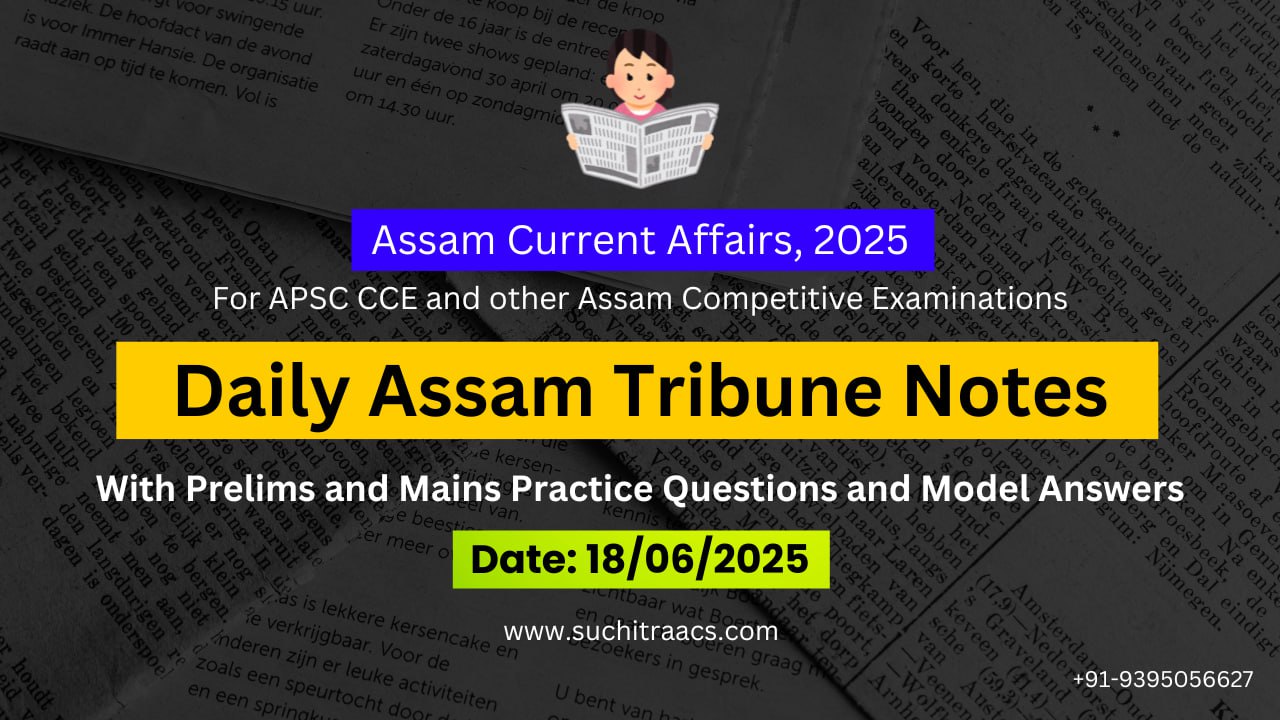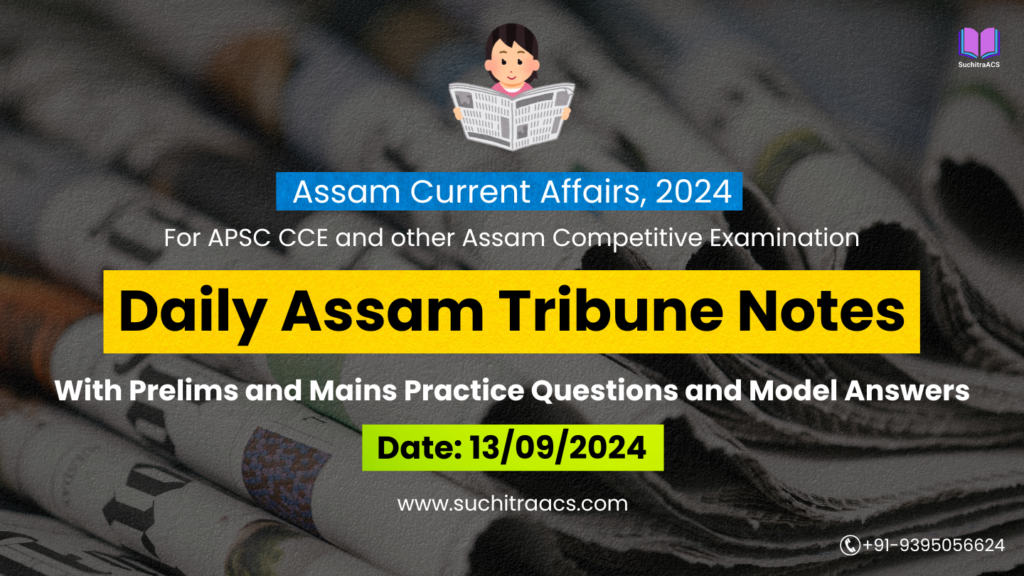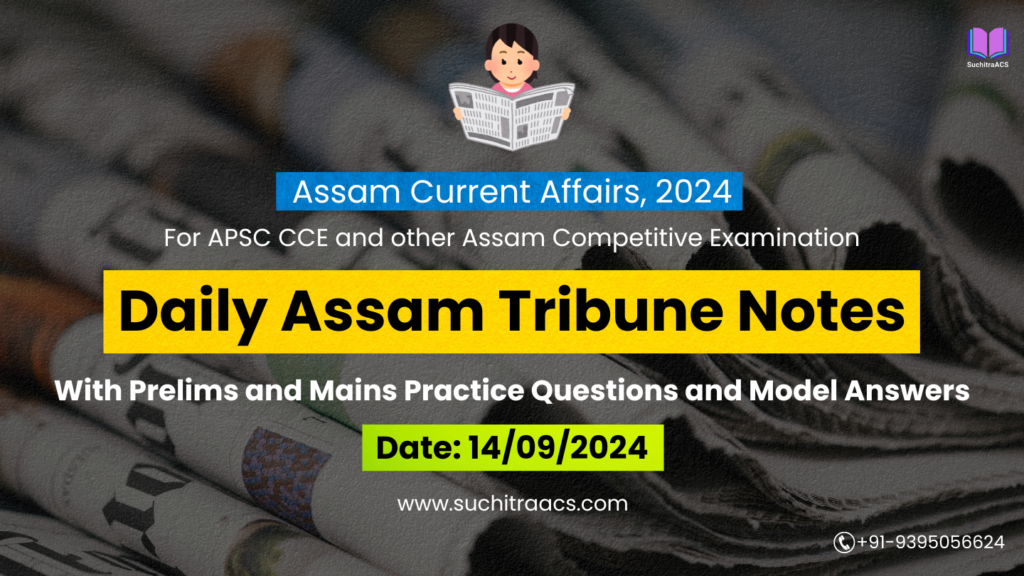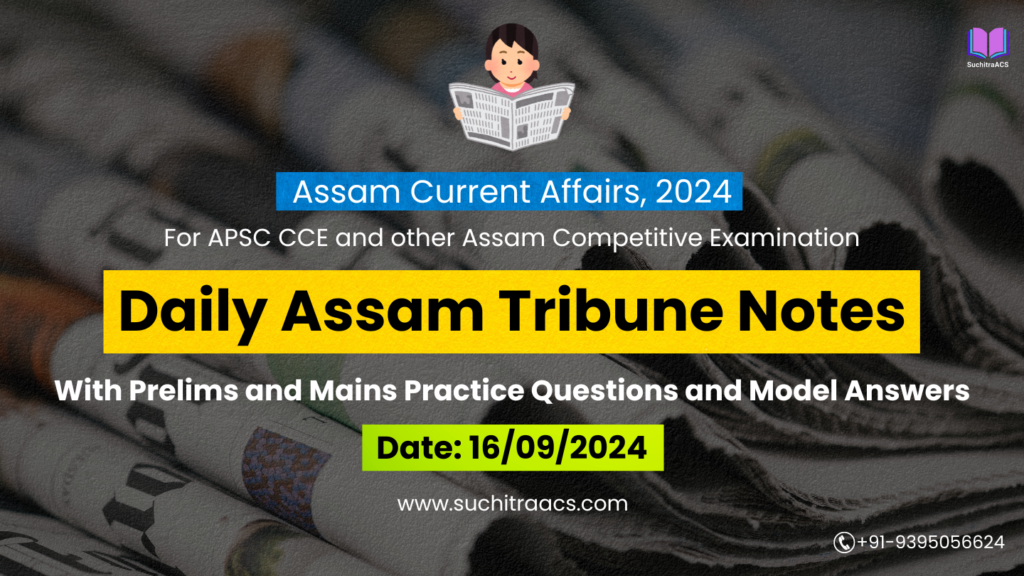APSC Current Affairs: Assam Tribune Notes with MCQs and Answer Writing (18/06/2025)
For APSC CCE and other Assam Competitive examinations aspirants, staying updated with current affairs is vital. This blog covers most important topics from the Assam Tribune today (18-06-2025). These issues are key for both APSC Prelims and Mains preparation, offering insights into the APSC CCE Syllabus.
✨ APSC CCE Online Coaching, 2026
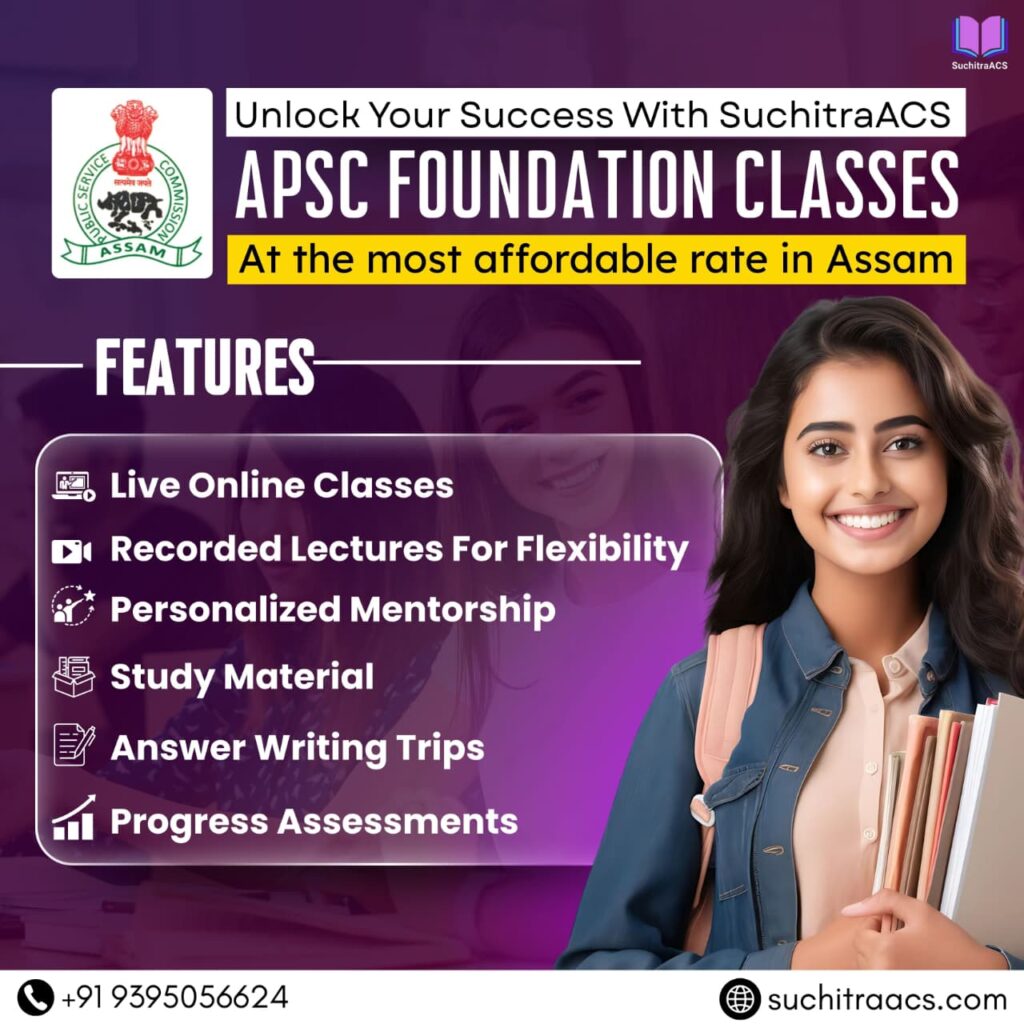
⚡ North East Power Conclave 2025: A Push for Renewable Energy Integration
📘 GS Paper 3: Infrastructure – Energy | Environment | Science & Tech
📘 GS Paper 2: Federalism | Inter-State Cooperation
📘 GS Paper 5 (APSC): Assam & NE Region – Energy Sector Development
🔹 Introduction
The North East Power Conclave 2025 was inaugurated in Guwahati, bringing together key stakeholders from across the Northeast. The event focused on sustainable energy solutions, regional grid integration, and unlocking the hydroelectric potential of the region. With over 500 participants, including state power ministers, the conclave addressed the unique challenges of the Northeast in achieving India’s green energy transition.
🔑 Key Points from the Conclave
| Theme | Details |
| ✅ Host City | Guwahati, Assam |
| 🧑💼 Organised By | Indian Electrical and Electronics Manufacturers’ Association (IEEMA) |
| 🌱 Focus Areas | Renewable energy, smart transmission, grid resilience |
| 🌊 Hydro Potential | ~58,000 MW capacity in NE region (untapped) |
| 🤝 Participants | Power Ministers & Secretaries from Nagaland, Mizoram; Power Grid, REC, NEEPCO |
| 💸 Investment Scope | ₹60,000–70,000 crore potential in the next decade |
🧠 Prelims Pointers
IEEMA: Apex industry association for electrical and electronic manufacturers
NEEPCO: North Eastern Electric Power Corporation Ltd., under Ministry of Power
Hydropower Potential (NE): Estimated at 58,000 MW – highest concentration in India
Green Energy Corridors: Transmission projects to integrate renewable power into the grid
Smart Grid: Digital energy infrastructure enabling real-time load balancing and fault detection
📝 Mains Pointers
A. Significance of Power Sector Development in NE
Enhances energy security and reduces dependence on Central grids
Enables industrialisation and job creation in border districts
Boosts rural electrification and infrastructure
Critical for India’s renewable energy targets (500 GW by 2030)
B. Major Challenges for Power Expansion in Northeast
| Challenge | Description |
| Geographical Terrain | Hilly regions make transmission projects logistically difficult |
| Infrastructural Lag | Old substation networks, limited smart metering |
| Funding Bottlenecks | Private investors reluctant due to low RoI and poor access |
| Inter-State Grid Coordination | Poor coordination between states delays projects |
| Environmental Concerns | Hydropower projects face opposition due to ecological sensitivity (e.g. Dibang valley) |
C. Strategic Recommendations
🌐 Grid Modernisation: Smart metering, AI-based grid management
🛰️ Use of Satellite Mapping: For planning hydro and transmission routes
🧑🤝🧑 PPP Models: Facilitate private sector entry with risk guarantees
🔄 Cross-Border Cooperation: Power export to Bangladesh, Bhutan, and Myanmar
🪫 Energy Storage: Invest in battery storage systems for intermittent renewables
🌍 Green Corridor Expansion: Synchronise NE’s renewable grid with national transmission lines
📑 Relevant Policies & Schemes
Revamped Distribution Sector Scheme (RDSS)
Hydropower Purchase Obligation (HPO) under Renewable Energy Targets
One Nation One Grid initiative
NE Vision 2035 by NITI Aayog
Assam State Renewable Energy Policy (2022)
🧭 Way Forward
| Path Ahead | Actions Needed |
| Regional Power Pooling | Build a regional coordination forum of NE states |
| Localised Solar Solutions | Promote rooftop solar in off-grid tribal belts |
| Skill Development | Green energy training centres in ITIs/polytechnics |
| Transparent Land Policy | Speed up clearances for hydro and solar parks |
| Gender & Equity Lens | Include SHGs in solar microgrid maintenance in rural areas |
🧩 Conclusion
The North East Power Conclave 2025 has underlined the untapped promise of Northeast India as a green power hub. With its immense hydro and solar potential, the region can drive India’s clean energy future—if challenges of policy, financing, and coordination are met head-on with innovation and inclusivity.
🛡️ Assam Police to Launch Women-Centric Mobile Patrolling Units
📘 GS Paper 2: Governance | Women’s Safety | Policing Reforms
📘 GS Paper 5 (APSC): Assam – Gender Justice | Public Order | Law & Order Reforms
🔹 Introduction
The Assam Police has announced the upcoming launch of dedicated women-centric mobile patrolling units in key urban centres, including Guwahati and Dibrugarh. These units aim to ensure round-the-clock safety of women in public spaces, especially in vulnerable areas such as markets, transport hubs, colleges, and nightlife zones. This is part of Assam’s broader strategy under Mission Shakti and Smart Policing Initiatives.
🔑 Key Features of the Initiative
| Feature | Description |
| 🚓 Patrol Units | Mobile squads exclusively focused on women’s safety |
| 👮♀️ Personnel | Female officers with gender-sensitisation training |
| 📍 Target Zones | Nightlife areas, markets, coaching centres, bus stands |
| 📱 Technology Use | Integration with 112 Emergency App and real-time tracking |
| 🧠 Public Engagement | Complaint redressal kiosks and feedback mechanism |
🧠 Prelims Pointers
Mission Shakti: Central scheme integrating women’s safety, empowerment, and institutional support
Nirbhaya Fund: Central corpus for women safety infrastructure and surveillance systems
112 India App: Pan-India emergency helpline with real-time location tracking
Safe City Project: Aims to create women-safe urban zones using CCTVs, patrols, and response teams
Assam Police: Among first in NE to establish Women Help Desks at all police stations
📝 Mains Pointers
A. Significance of Mobile Patrols for Women’s Safety
| Dimension | Benefit |
| Crime Deterrence | Presence of dedicated patrol reduces incidents of molestation, stalking |
| Public Confidence | Women feel safer commuting at night or accessing public spaces |
| Speedy Redressal | Enables swift response to distress calls via integrated emergency platforms |
| Gender Sensitivity | Female officers ensure better handling of cases involving abuse or harassment |
| Inclusive Policing | Builds police-public trust, especially in student and working women populations |
B. Challenges in Implementation
| Challenge | Description |
| Resource Constraints | Shortage of women personnel in lower police ranks |
| Patriarchal Resistance | Gender biases within force and local communities |
| Urban Design Gaps | Poor lighting, no surveillance in key hotspots |
| Digital Divide | Many rural women still unaware of emergency helplines and safety apps |
| Follow-Up System Weakness | FIRs often delayed or dropped post-patrol intervention |
📑 Key Policies and Reports
Justice Verma Committee Report (2013) – Advocated for gender-sensitive policing and rapid response
Bureau of Police Research & Development (BPR&D) – Model Framework for Women’s Safety
Mission Shakti Guidelines (2022) – Institutional support for State Gender Police Units
NCRB Crime Against Women Report (2023) – Assam ranks high in certain categories of gender violence
UN Women India Safety Audit Toolkit – Global best practices in urban gender safety
🧭 Way Forward
| Strategy | Recommendation |
| Women Constable Recruitment | Fast-track hiring for 33% representation in urban units |
| Tech-Enabled Safety Map | Use crowd-sourced mobile apps to flag unsafe zones |
| School & College Outreach | Build trust by educating youth on reporting and response systems |
| Gender Audit of Cities | Conduct periodic assessments of lighting, transport, and visibility |
| Community Policing Cells | Involve local women SHGs, teachers, and students in feedback and planning |
🧩 Conclusion
Women’s safety is not merely a law-and-order issue—it is central to urban inclusivity and dignity. Assam’s mobile patrol initiative marks a progressive policing reform, but must be backed by infrastructure, legal follow-through, and cultural change. When a woman can walk freely at any hour, we’ll know the patrols have succeeded.
🧑🌾 PM Reviews Flood Preparedness in Northeastern States: Governance and Disaster Risk Reduction
📘 GS Paper 2: Governance | Centre-State Relations | Disaster Preparedness
📘 GS Paper 3: Disaster Management | Climate Adaptation
📘 GS Paper 5 (APSC): Assam – Flood Management | Inter-State Coordination | River Systems
🔹 Introduction
Prime Minister Narendra Modi held a virtual high-level review meeting with Chief Ministers and senior officials of Northeastern states, including Assam, Arunachal Pradesh, and Manipur, to assess monsoon preparedness and flood mitigation efforts. Assam’s annual flooding due to the Brahmaputra and its tributaries remains a recurring humanitarian and economic crisis.
🔑 Key Highlights
| Item | Detail |
| 🧑💼 Chaired By | Prime Minister Narendra Modi |
| 🛟 Focus Areas | Early warning systems, embankment repair, disaster funds utilisation |
| 🏞️ Affected States | Assam, Arunachal Pradesh, Manipur, Nagaland |
| 🧾 Central Directives | Accelerated fund release under SDRF & NDRF; SOP compliance |
| ⚙️ Tech Emphasis | ISRO inputs for flood mapping, use of drones for relief tracking |
| 💬 Assam’s Submission | 33 districts prone to flooding; state seeks Centre’s help on embankments, inland rescue capacity |
🧠 Prelims Pointers
SDRF (State Disaster Response Fund): First line of funding for state-level disaster management
NDRF (National Disaster Response Fund): Additional support for large-scale calamities
NDMA: Apex disaster planning body under the Disaster Management Act, 2005
Brahmaputra Floodplain: Subject to high discharge volume, sedimentation, and bank erosion
CWC & IMD: Key agencies in flood forecasting and hydro-meteorological alerts
📝 Mains Pointers
A. Assam’s Flood Crisis – A Governance Challenge
Affects 30–35 lakh people annually
Damage to crops, homes, livestock, and roads
Triggers displacement in char (river island) areas
Worsens poverty and school dropout rates
B. Central-State Coordination Measures
| Area | Example |
| Early Warning Systems | Real-time alerts via mobile networks in collaboration with IMD |
| Rescue Infrastructure | Boats, rescue equipment, helipads in Barpeta, Dhemaji, Dibrugarh |
| Embankment Repair | Long-term embankment strengthening under floodplain zoning plans |
| Capacity Building | Training of SDRF personnel in swift water rescue techniques |
C. Structural and Non-Structural Interventions
| Type | Measure |
| Structural | Embankments, raised roads, water pumps, river interlinking ideas |
| Non-Structural | Community flood mapping, seasonal relocation planning, crop insurance |
| Technological | Satellite flood modelling (NESAC), remote-sensing for relief operations |
| Community-Based | School-shelter conversion plans, local disaster committees |
📑 Policies & Reports
Disaster Management Act, 2005
Brahmaputra Board – central agency for flood and erosion control
Assam State Action Plan on Climate Change (SAPCC)
Sendai Framework for Disaster Risk Reduction (2015–30)
🧭 Way Forward
| Area | Action Needed |
| Permanent Shelters | Build climate-resilient homes in flood-vulnerable zones |
| Floodplain Zoning Law | Legally demarcate areas unsuitable for habitation or construction |
| Sustainable Infrastructure | Encourage stilt houses, floating classrooms, amphibious designs |
| Community Mobilisation | Use SHGs and panchayats in relief logistics and awareness campaigns |
| Funding Efficiency | Monitor SDRF/NDRF utilisation with third-party audits |
🧩 Conclusion
Floods in Assam are no longer “natural disasters” — they are administrative and planning failures magnified by climate change. Strong Centre-State synergy, backed by science, early warning, and community-rooted governance, can transform response from relief to resilience.
🏛️ Supreme Court Directive on Preventing Misuse of Government Advertisements
📘 GS Paper 2: Governance | Judiciary | Ethics in Public Administration
📘 GS Paper 4: Integrity | Political Neutrality | Misuse of Public Resources
📘 GS Paper 5 (APSC): Assam – Centre-State Relations | Administrative Ethics
🔹 Introduction
The Supreme Court of India, responding to petitions over misuse of taxpayer-funded government advertisements for political image-building, has issued a fresh directive to strictly enforce its 2015 guidelines. The move comes after complaints from civil society groups and opposition parties regarding the politicisation of public schemes, including alleged violations by state governments.
🔑 Key Facts
| Detail | Description |
| 🏛️ Issued By | Supreme Court of India |
| 📜 Original Guidelines | Based on 2015 SC order in Common Cause vs. Union of India |
| ❌ Core Prohibitions | Ads cannot include political party symbols, slogans, or leaders’ images (except PM, CM, President) |
| 👥 Committee Oversight | Three-member Content Regulation Committee for Government Advertising (CRGA) in each state |
| 📌 Relevance for Assam | Similar concerns raised earlier regarding excessive publicity during state schemes and elections |
🧠 Prelims Pointers
Common Cause vs. Union of India (2015): Landmark SC judgment framing rules for public-funded ads
Article 282: Grants the Union and states power to make grants for public purpose
Comptroller and Auditor General (CAG): Can audit government advertising budgets
Central Bureau of Communication (CBC): Nodal agency for publicity of Central Government
RTI Act, 2005: Enables tracking of expenditure on advertisements by public bodies
📝 Mains Pointers
A. Why Government Ad Misuse is a Governance Issue
| Area | Concern |
| Misuse of Public Money | Taxpayer funds used for political mileage instead of public service info |
| Undermines Fair Play | Creates undue advantage for ruling party, affecting electoral neutrality |
| Lack of Transparency | No audit of volume, content, or placement of ads |
| Erodes Public Trust | People view schemes as personal charity of political leaders |
| Information Distortion | Data may be cherry-picked, achievements exaggerated |
B. Ethical Dimensions (GS Paper 4)
Political Neutrality: Civil servants must not allow public funds to promote partisan interests
Integrity & Accountability: Responsible use of state resources
Probity in Governance: Transparency in communication and publicity
Public Service Orientation: Public interest must override personal or party branding
📑 Relevant Reports & Guidelines
SC Guidelines (2015) – No use of ruling party symbols, slogans, personal glorification
Content Regulation Committee – Must vet ads before release
CEC Recommendations – Advertising freeze during elections
2nd ARC Report on Ethics in Governance – Advises codes of conduct for govt communication
🧭 Way Forward
| Recommendation | Actionable Suggestion |
| Audit Publicity Budgets | CAG and State AGs must publish annual ad expenditure reports |
| CRGA Empowerment | Make oversight committee independent with legal backing |
| Civic Literacy Campaigns | Educate public that welfare schemes are constitutional rights, not gifts |
| Digital Monitoring | Use RTI portals and dashboard tracking for all ad releases |
| Civil Service Training | Reinforce neutrality and ethics in administrative communication |
🧩 Conclusion
When public money is used for private image-building, democracy and ethics suffer. The Supreme Court’s intervention is timely, but real reform depends on ethical governance, vigilant institutions, and citizen awareness. Transparency must be at the heart of all public communication.
APSC Prelims Practice Questions
✅ Topic 1: North East Power Conclave 2025
1. Which of the following statements is/are correct about the power sector in Northeast India?
- The region has an estimated hydropower potential of over 50,000 MW.
- North Eastern Electric Power Corporation (NEEPCO) operates under the Ministry of Power.
- Assam has the highest solar energy generation in the Northeast.
Select the correct code:
A. 1 and 2 only ✅
B. 2 and 3 only
C. 1 and 3 only
D. 1, 2 and 3
🧠 Explanation:
- Statement 1: Correct – NE India has a hydropower potential of over 58,000 MW.
- Statement 2: Correct – NEEPCO is under the Ministry of Power.
- Statement 3: Incorrect – While Assam has solar projects, it does not lead solar generation; Meghalaya and Arunachal are catching up.
2. “Green Energy Corridor” is associated with:
A. Linking SEZs with renewable energy clusters
B. Transmission networks for integrating renewable power into the national grid ✅
C. Railway electrification under Green Railways
D. Cross-border energy trade with Bangladesh
🧠 Explanation:
The Green Energy Corridor is a project to facilitate inter-state and intra-state transmission of renewable power, especially from solar and wind-rich regions.
✅ Topic 2: Women-Centric Patrolling Units by Assam Police
3. Which of the following initiatives aim to improve women’s safety in India?
- 112 India Emergency App
- Nirbhaya Fund
- Mission Shakti
- Smart Policing Guidelines by BPR&D
Select the correct answer:
A. 1 and 2 only
B. 1, 2 and 3 only
C. 1, 2, 3 and 4 ✅
D. 2 and 4 only
🧠 Explanation:
All four are part of India’s women safety ecosystem, either through tech (112 app), infrastructure (Nirbhaya Fund), empowerment (Mission Shakti), or reform (BPR&D Smart Policing).
4. Which of the following statements about Mission Shakti is true?
A. It is a state scheme of Uttar Pradesh.
B. It is a National Skill Development programme.
C. It integrates multiple women empowerment schemes under one umbrella. ✅
D. It provides reservation for women in Panchayati Raj elections.
🧠 Explanation:
Mission Shakti is a centrally sponsored scheme launched in 2021 that integrates schemes like Beti Bachao Beti Padhao, Women Helpline, and One-Stop Centres.
✅ Topic 3: PM’s Flood Preparedness Meeting with NE States
5. Which of the following correctly pairs the disaster-related agency with its function?
| Agency | Function |
| 1. NDMA | Disaster Response at field level |
| 2. SDRF | State’s disaster response fund |
| 3. IMD | Early cyclone & rainfall alerts |
| 4. NESAC | Satellite-based flood monitoring |
Select the correct code:
A. 1, 2 and 3 only
B. 2, 3 and 4 only ✅
C. 1, 3 and 4 only
D. All four
🧠 Explanation:
- NDMA = Policy formulation, not field response (NDRF does field response)
- SDRF = Correct
- IMD = Correct
- NESAC (North Eastern Space Applications Centre) = Uses satellite data for flood forecasting and damage mapping
6. Which article empowers both the Union and States to make grants for public purposes including disaster relief?
A. Article 280
B. Article 275
C. Article 282 ✅
D. Article 263
🧠 Explanation:
Article 282 allows Union and States to make grants for public purposes, such as disaster response, beyond constitutional obligations.
✅ Topic 4: Supreme Court on Misuse of Government Advertisements
7. In the 2015 judgment Common Cause v. Union of India, the Supreme Court issued guidelines related to:
A. Electoral reforms
B. Use of Aadhaar in welfare schemes
C. Public-funded government advertisements ✅
D. Decriminalisation of politics
🧠 Explanation:
The judgment restricted misuse of government-funded ads to promote political parties or leaders (except PM, CM, President).
8. The “Content Regulation Committee” for Government Advertisements is primarily responsible for:
A. Promoting cultural sensitivity in broadcast content
B. Licensing private media houses
C. Vetting government ads for political neutrality ✅
D. Approving state budgets for outreach programs
🧠 Explanation:
The Committee ensures that government advertisements remain objective, free from political glorification, and in line with SC norms.
APSC Mains Practice Question
📝 Mains Question:
Q. “The misuse of taxpayer-funded government advertisements erodes both governance ethics and electoral fairness.” Discuss the recent Supreme Court directive in this context and suggest a framework to ensure transparency in public communication.
📘 Model Answer
Introduction
Publicly funded advertisements are intended to inform citizens about welfare schemes, rights, and public services. However, when these are misused to promote political leaders or parties, they violate principles of political neutrality, fiscal accountability, and ethical governance. Recognising this, the Supreme Court recently reiterated its 2015 guidelines to curb such misuse, mandating strict oversight by regulatory committees in states.
Why Misuse of Government Advertisements is a Problem
| Concern | Impact |
| Violation of Public Trust | Turns welfare schemes into instruments of personal or party glorification |
| Electoral Unfairness | Creates undue advantage for ruling parties, distorting the level playing field |
| Waste of Public Money | Crores spent on image-building rather than critical outreach or service delivery |
| Undermines Democratic Values | Promotes a personality cult over institutional accountability |
| Transparency Deficit | Limited public access to ad budgets, approvals, and content audits |
Supreme Court’s Intervention (Common Cause v. Union of India, 2015)
- Prohibited use of leader images (except PM, CM, President, CJI)
- Mandated formation of a Content Regulation Committee (CRGA) in each state
- Emphasised non-partisan, factual communication
- Recently reaffirmed in 2025 due to violations in multiple states (including NE region)
Ethical Dimensions (GS Paper 4 Overlap)
- Integrity & Accountability: Use of state funds must be purpose-driven and justifiable
- Political Neutrality: Administrators must resist pressure to use resources for party propaganda
- Probity in Public Life: Leaders must avoid self-promotion using taxpayer money
- Transparency: Citizens have a right to know how their money is being spent
Way Forward: Framework for Ethical and Transparent Public Communication
| Area | Recommendation |
| Institutional Oversight | Strengthen and empower CRGAs with real-time veto powers |
| Audit Mechanisms | Annual CAG/State AG reports on ad expenditure across departments |
| Digital Dashboard | Public portal for accessing government ads, budgets, and approvals |
| Legal Backing | Amendments in Rules of Business to define ad ethics and penalties |
| Public Awareness | Educate citizens that schemes are their rights, not gifts from leaders |
Case Example: Assam Context
- Reports of excessive promotional hoardings for state schemes in past election cycles
- Civil society in Assam has previously petitioned for ad transparency
- Opportunity for Assam to become a model by enforcing SC norms strictly
Conclusion
The Supreme Court’s directive is a necessary judicial push to restore the ethical compass of public governance. Government communication must be informational, not ornamental. When political neutrality and fiscal accountability are upheld, democracy is strengthened, and public trust is earned.
✨ APSC CCE Courses, 2025-26 offered by SuchitraACS
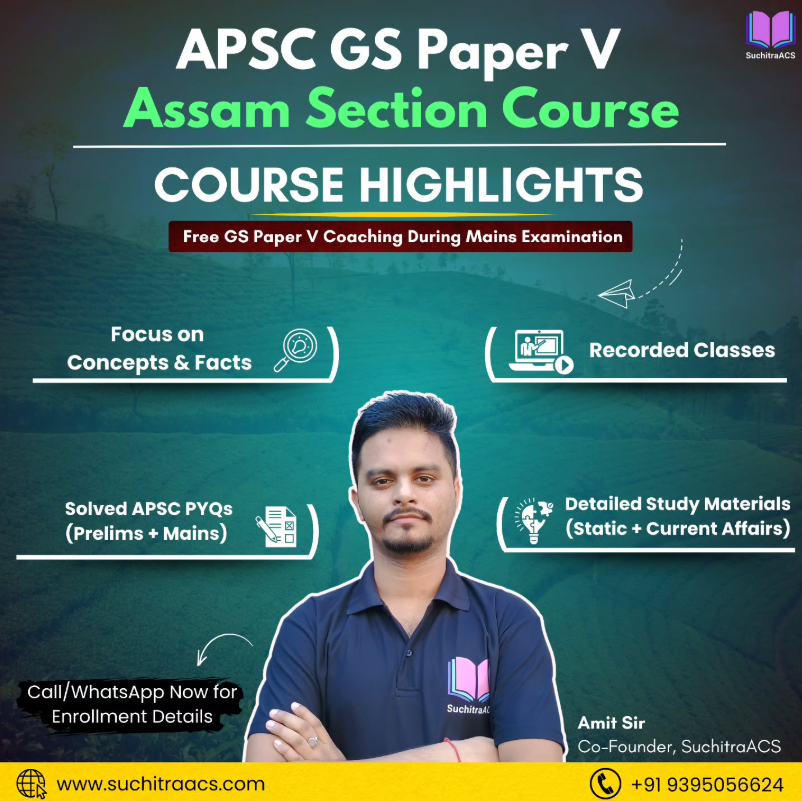

🔔 Join Our WhatsApp Study Group!
For exclusive access to premium quality content, including study materials, current affairs, MCQs, and model answers for APSC CCE and other Assam competitive exams.
Click here to join: SuchitraACS Study WhatsApp Group
📚 Want to know more about SuchitraACS’s most affordable courses?
Click here to know more: SuchitraACS Courses for APSC CCE and Assam Competitive Examinations

